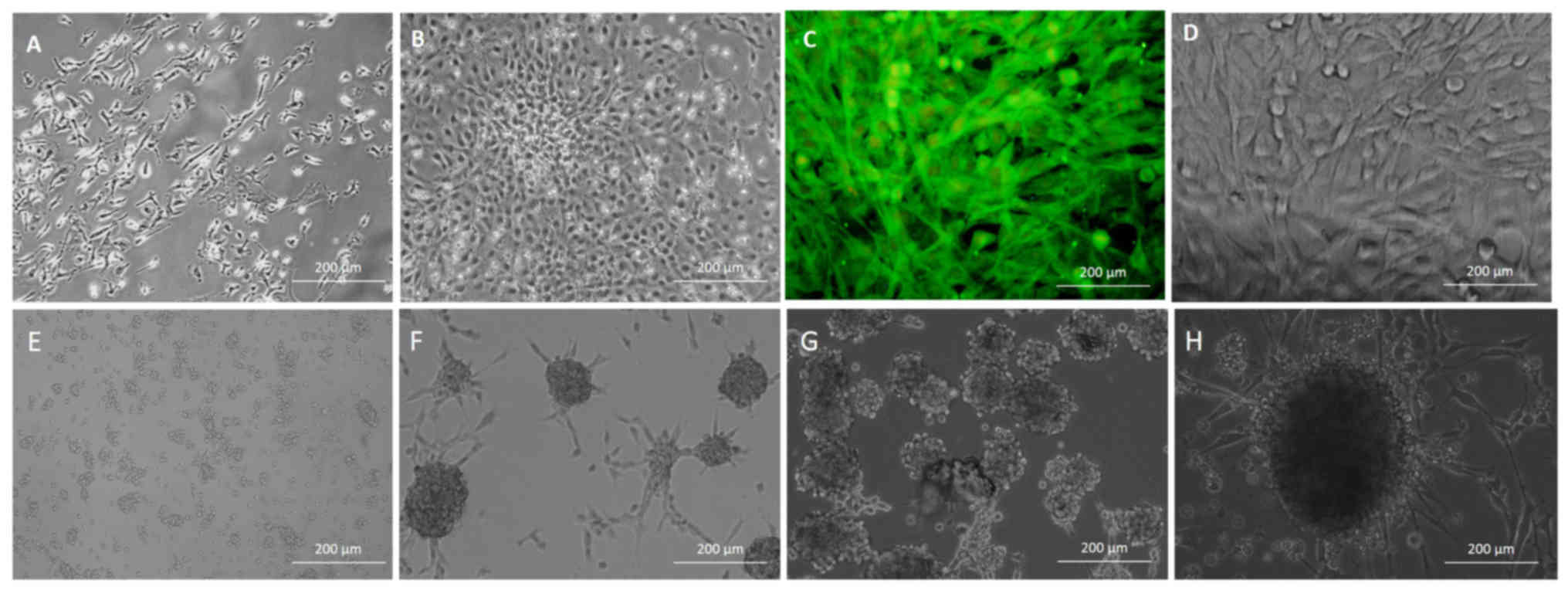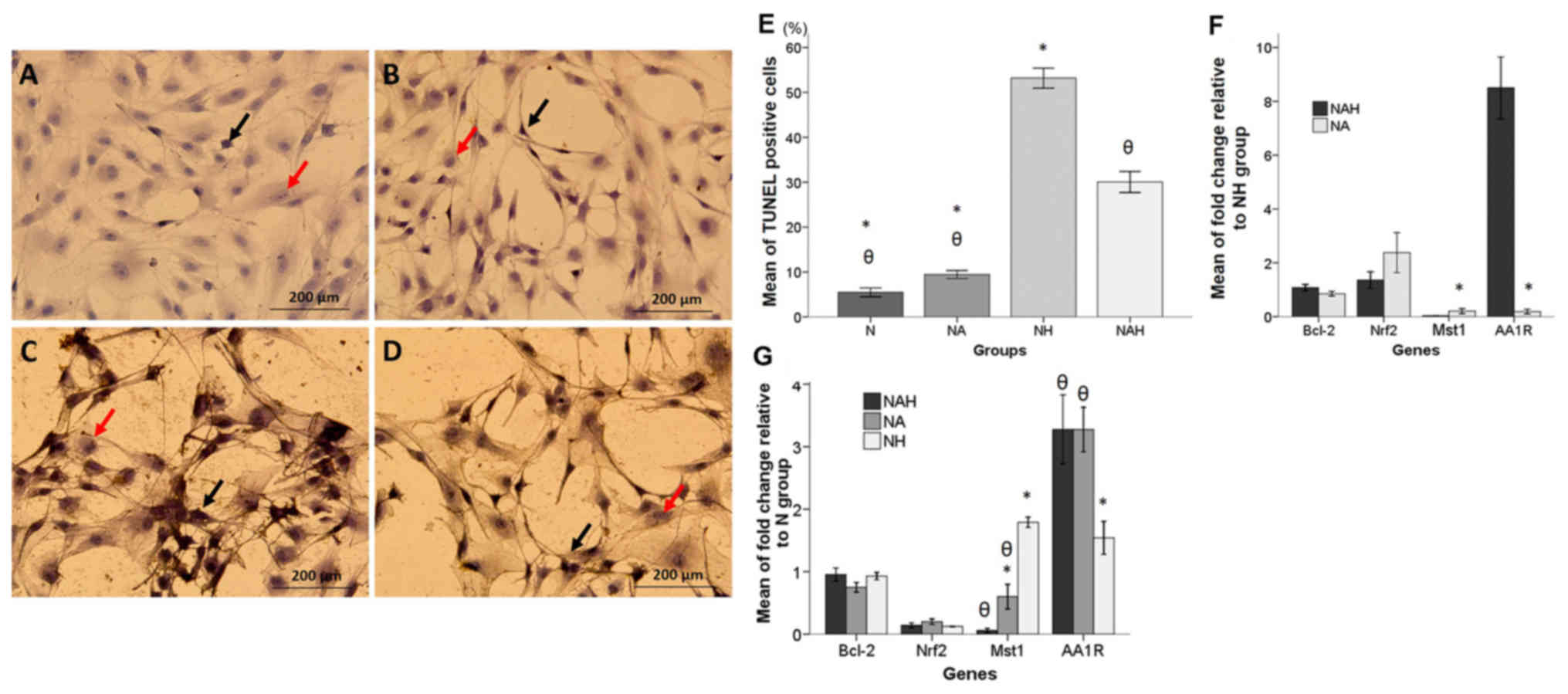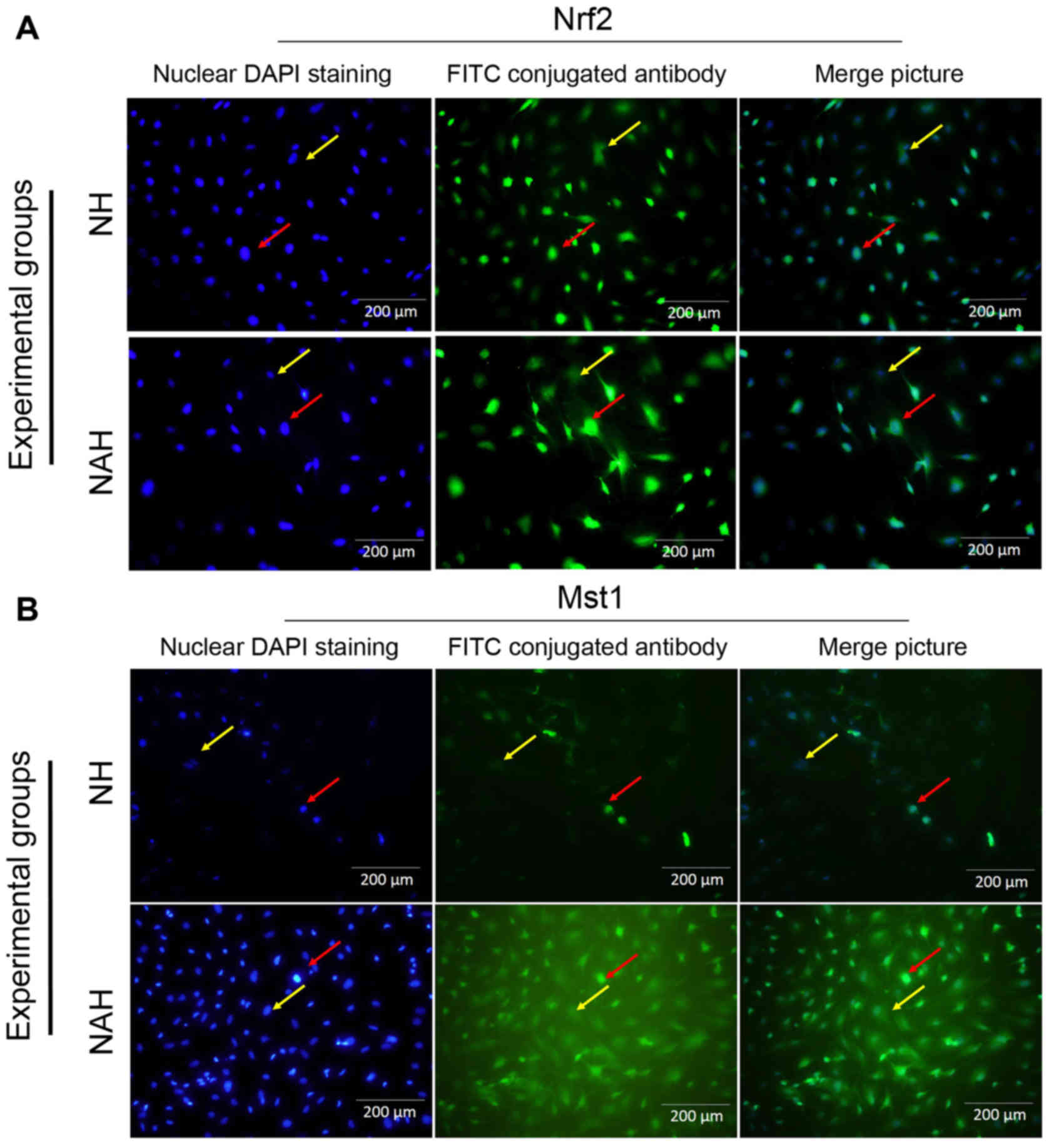|
1
|
Yeh LK, Liu CY, Chien CL, Converse RL, Kao
WW, Chen MS, Hu FR, Hsieh FJ and Wang IJ: Molecular analysis and
characterization of zebrafish keratocan (zKera) gene. J Biol Chem.
283:506–517. 2008. View Article : Google Scholar : PubMed/NCBI
|
|
2
|
Chen X, Guo C and Kong J: Oxidative stress
in neurodegenerative diseases. Neural Regen Res. 7:376–385.
2012.PubMed/NCBI
|
|
3
|
Uttara B, Singh AV, Zamboni P and Mahajan
RT: Oxidative stress and neurodegenerative diseases: A review of
upstream and downstream antioxidant therapeutic options. Curr
Neuropharmacol. 7:65–74. 2009. View Article : Google Scholar : PubMed/NCBI
|
|
4
|
Liu Z, Liu Y, Gao R, Li H, Dunn T, Wu P,
Smith RG, Sarkar PS and Fang X: Ethanol suppresses PGC-1α
expression by interfering with the cAMP-CREB pathway in neuronal
cells. PLoS One. 9:e1042472014. View Article : Google Scholar : PubMed/NCBI
|
|
5
|
Cunha RA: Adenosine as a neuromodulator
and as a homeostatic regulator in the nervous system: Different
roles, different sources and different receptors. Neurochem Int.
38:107–125. 2001. View Article : Google Scholar : PubMed/NCBI
|
|
6
|
Xu L, Xu H, Cao Y, Yang P, Feng Y, Tang Y,
Yuan S and Ming J: Validation of reference genes for quantitative
real-time PCR during bicolor tepal development in asiatic hybrid
lilies (Lilium spp.). Front Plant Sci. 8:6692017. View Article : Google Scholar : PubMed/NCBI
|
|
7
|
Gorman AM: Neuronal cell death in
neurodegenerative diseases: Recurring themes around protein
handling. J Cell Mol Med. 12(6A): 2263–2280. 2008. View Article : Google Scholar : PubMed/NCBI
|
|
8
|
Gibson RM: Does apoptosis have a role in
neurodegeneration? BMJ. 322:1539–1540. 2001. View Article : Google Scholar : PubMed/NCBI
|
|
9
|
Mattson MP: Apoptosis in neurodegenerative
disorders. Nat Rev Mol Cell Biol. 1:120–129. 2000. View Article : Google Scholar : PubMed/NCBI
|
|
10
|
Abdanipour A, Tiraihi T and
Mirnajafi-Zadeh J: Improvement of the pilocarpine epilepsy model in
rat using bone marrow stromal cell therapy. Neurol Res. 33:625–632.
2011. View Article : Google Scholar : PubMed/NCBI
|
|
11
|
Racine RJ: Modification of seizure
activity by electrical stimulation. II. Motor seizure.
Electroencephalogr Clin Neurophysiol. 32:281–294. 1972. View Article : Google Scholar : PubMed/NCBI
|
|
12
|
Collak FK, Yagiz K, Luthringer DJ, Erkaya
B and Cinar B: Threonine-120 phosphorylation regulated by
phosphoinositide-3-kinase/Akt and mammalian target of rapamycin
pathway signaling limits the antitumor activity of mammalian
sterile 20-like kinase 1. J Biol Chem. 287:23698–23709. 2012.
View Article : Google Scholar : PubMed/NCBI
|
|
13
|
Ardestani A, Paroni F, Azizi Z, Kaur S,
Khobragade V, Yuan T, Frogne T, Tao W, Oberholzer J, Pattou F, et
al: MST1 is a key regulator of beta cell apoptosis and dysfunction
in diabetes. Nat Med. 20:385–397. 2014. View Article : Google Scholar : PubMed/NCBI
|
|
14
|
Ura S, Masuyama N, Graves JD and Gotoh Y:
MST1-JNK promotes apoptosis via caspase-dependent and independent
pathways. Genes Cells. 6:519–530. 2001. View Article : Google Scholar : PubMed/NCBI
|
|
15
|
Strom J, Xu B, Tian X and Chen QM: Nrf2
protects mitochondrial decay by oxidative stress. FASEB J.
30:66–80. 2016. View Article : Google Scholar : PubMed/NCBI
|
|
16
|
Murata H, Takamatsu H, Liu S, Kataoka K,
Huh NH and Sakaguchi M: NRF2 regulates PINK1 expression under
oxidative stress conditions. PLoS One. 10:e01424382015. View Article : Google Scholar : PubMed/NCBI
|
|
17
|
Zhong J and Li L: Skin-derived precursors
against UVB-induced apoptosis via Bcl-2 and Nrf2 upregulation.
Biomed Res Int. 2016:68947432016. View Article : Google Scholar : PubMed/NCBI
|
|
18
|
Maleki M, Ghanbarvand F, Behvarz Reza M,
Ejtemaei M and Ghadirkhomi E: Comparison of mesenchymal stem cell
markers in multiple human adult stem cells. Int J Stem Cells.
7:118–126. 2014. View Article : Google Scholar : PubMed/NCBI
|
|
19
|
Yang Q, Mu J, Li Q, Li A, Zeng Z, Yang J,
Zhang X, Tang J and Xie P: A simple and efficient method for
deriving neurospheres from bone marrow stromal cells. Biochem
Biophys Res Commun. 372:520–524. 2008. View Article : Google Scholar : PubMed/NCBI
|
|
20
|
Suzuki S, Namiki J, Shibata S, Mastuzaki Y
and Okano H: The neural stem/progenitor cell marker nestin is
expressed in proliferative endothelial cells, but not in mature
vasculature. J Histochem Cytochem. 58:721–730. 2010. View Article : Google Scholar : PubMed/NCBI
|
|
21
|
Albrecht-Küpper BE, Leineweber K and Nell
PG: Partial adenosine A1 receptor agonists for cardiovascular
therapies. Purinergic Signal. 8 Suppl 1:91–99. 2012. View Article : Google Scholar
|
|
22
|
Abbasnia K, Ghanbari A, Abedian M,
Ghanbari A, Sharififar S and Azari H: The effects of repetitive
transcranial magnetic stimulation on proliferation and
differentiation of neural stem cells. Anat Cell Biol. 48:104–113.
2015. View Article : Google Scholar : PubMed/NCBI
|
|
23
|
Lee JH, Cheon YH, Woo RS, Song DY, Moon C
and Baik TK: Evidence of early involvement of apoptosis inducing
factor-induced neuronal death in Alzheimer brain. Anat Cell Biol.
45:26–37. 2012. View Article : Google Scholar : PubMed/NCBI
|
|
24
|
Mori M, Nishizaki T and Okada Y:
Protective effect of adenosine on the anoxic damage of hippocampal
slice. Neuroscience. 46:301–307. 1992. View Article : Google Scholar : PubMed/NCBI
|
|
25
|
Cunha RA: Neuroprotection by adenosine in
the brain: From A(1) receptor activation to A (2A) receptor
blockade. Purinergic Signal. 1:111–134. 2005. View Article : Google Scholar : PubMed/NCBI
|
|
26
|
Migita H, Kominami K, Higashida M,
Maruyama R, Tuchida N, McDonald F, Shimada F and Sakurada K:
Activation of adenosine A1 receptor-induced neural stem cell
proliferation via MEK/ERK and Akt signaling pathways. J Neurosci
Res. 86:2820–2828. 2008. View Article : Google Scholar : PubMed/NCBI
|
|
27
|
Elmore S: Apoptosis: A review of
programmed cell death. Toxicol Pathol. 35:495–516. 2007. View Article : Google Scholar : PubMed/NCBI
|
|
28
|
Huang NK: Adenosine A2A receptors regulate
oxidative stress formation in rat pheochromocytoma PC12 cells
during serum deprivation. Neurosci Lett. 350:127–131. 2003.
View Article : Google Scholar : PubMed/NCBI
|
|
29
|
Ramkumar V, Hallam DM and Nie Z:
Adenosine, oxidative stress and cytoprotection. Jpn J Pharmacol.
86:265–274. 2001. View Article : Google Scholar : PubMed/NCBI
|
|
30
|
Vitolo OV, Ciotti MT, Galli C, Borsello T
and Calissano P: Adenosine and ADP prevent apoptosis in cultured
rat cerebellar granule cells. Brain Res. 809:297–301. 1998.
View Article : Google Scholar : PubMed/NCBI
|
|
31
|
DeMaagd G and Philip A: Parkinson's
disease and its management: Part 1: Disease entity, risk factors,
pathophysiology, clinical presentation, and diagnosis. P T.
40:504–532. 2015.PubMed/NCBI
|
|
32
|
Zhai W, Chen D, Shen H, Chen Z, Li H, Yu Z
and Chen G: A1 adenosine receptor attenuates intracerebral
hemorrhage-induced secondary brain injury in rats by activating the
P38-MAPKAP2-Hsp27 pathway. Mol Brain. 9:662016. View Article : Google Scholar : PubMed/NCBI
|
|
33
|
Meng Z, Moroishi T and Guan KL: Mechanisms
of Hippo pathway regulation. Genes Dev. 30:1–17. 2016. View Article : Google Scholar : PubMed/NCBI
|
|
34
|
Wrann CD, White JP, Salogiannnis J,
Laznik-Bogoslavski D, Wu J, Ma D, Lin JD, Greenberg ME and
Spiegelman BM: Exercise induces hippocampal BDNF through a
PGC-1α/FNDC5 pathway. Cell Metab. 18:649–659. 2013. View Article : Google Scholar : PubMed/NCBI
|
|
35
|
Youdim MB: The path from anti Parkinson
drug selegiline and rasagiline to multifunctional neuroprotective
anti Alzheimer drugs ladostigil and m30. Curr Alzheimer Res.
3:541–550. 2006. View Article : Google Scholar : PubMed/NCBI
|
|
36
|
Alexander GE: Biology of Parkinson's
disease: Pathogenesis and pathophysiology of a multisystem
neurodegenerative disorder. Dialogues Clin Neurosci. 6:259–280.
2004.PubMed/NCBI
|
|
37
|
Sarkar S, Raymick J and Imam S:
Neuroprotective and therapeutic strategies against Parkinson's
disease: Recent Perspectives. Int J Mol Sci. 17:172016. View Article : Google Scholar
|
|
38
|
Pingle SC, Jajoo S, Mukherjea D, Sniderhan
LF, Jhaveri KA, Marcuzzi A, Rybak LP, Maggirwar SB and Ramkumar V:
Activation of the adenosine A1 receptor inhibits HIV-1 tat-induced
apoptosis by reducing nuclear factor-kappaB activation and
inducible nitric-oxide synthase. Mol Pharmacol. 72:856–867. 2007.
View Article : Google Scholar : PubMed/NCBI
|
|
39
|
Han J, Talorete TP, Yamada P and Isoda H:
Anti-proliferative and apoptotic effects of oleuropein and
hydroxytyrosol on human breast cancer MCF-7 cells. Cytotechnology.
59:45–53. 2009. View Article : Google Scholar : PubMed/NCBI
|
|
40
|
Zhang Z, Zhou S, Jiang X, Wang YH, Li F,
Wang YG, Zheng Y and Cai L: The role of the Nrf2/Keap1 pathway in
obesity and metabolic syndrome. Rev Endocr Metab Disord. 16:35–45.
2015. View Article : Google Scholar : PubMed/NCBI
|
|
41
|
Ishikawa T: Genetic polymorphism in the
NRF2 gene as a prognosis marker for cancer chemotherapy. Front
Genet. 5:3832014. View Article : Google Scholar : PubMed/NCBI
|
|
42
|
Nuydens R, Dispersyn G, Van Den Keiboom G,
de Jong M, Connors R, Ramaekers F, Borgers M and Geerts H: Bcl-2
protects against apoptosis-related microtubule alterations in
neuronal cells. Apoptosis. 5:43–51. 2000. View Article : Google Scholar : PubMed/NCBI
|
|
43
|
Anedda A, López-Bernardo E, Acosta-Iborra
B, Suleiman Saadeh M, Landázuri MO and Cadenas S: The transcription
factor Nrf2 promotes survival by enhancing the expression of
uncoupling protein 3 under conditions of oxidative stress. Free
Radic Biol Med. 61:395–407. 2013. View Article : Google Scholar : PubMed/NCBI
|
|
44
|
Jeong YH, Park JS, Kim DH and Kim HS:
Lonchocarpine increases Nrf2/ARE-mediated antioxidant enzyme
expression by modulating AMPK and MAPK signaling in brain
astrocytes. Biomol Ther (Seoul). 24:581–588. 2016. View Article : Google Scholar : PubMed/NCBI
|
|
45
|
Birben E, Sahiner UM, Sackesen C, Erzurum
S and Kalayci O: Oxidative stress and antioxidant defense. World
Allergy Organ J. 5:9–19. 2012. View Article : Google Scholar : PubMed/NCBI
|















